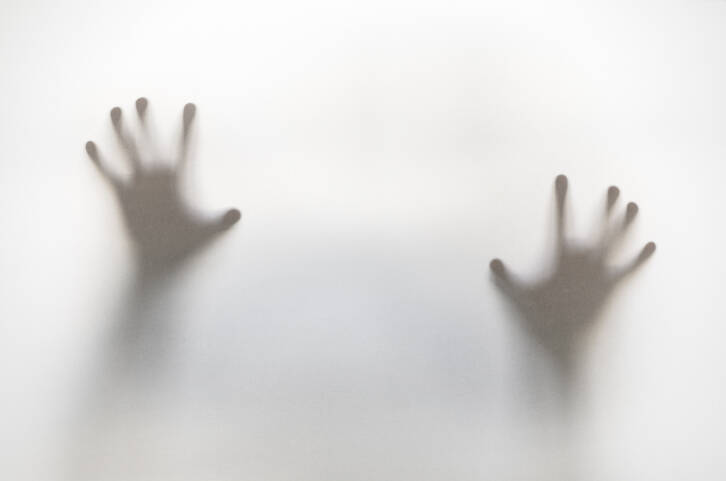Nightmares: Why do they occur and how can we stop them? What about nightmares in children?

Nightmares are intense, negatively perceived, unpleasant dreams. They afflict the sufferer by causing fear, anxiety, sadness or anger. This sleep disorder occurs mainly in children, but also in adulthood. It is associated with body movements, rapid breathing, and various sound manifestations.
Most common symptoms
- Malaise
- Headache
- Spirituality
- Depression - depressed mood
- Sweating
- Concentration disorders
- Mood disorders
- Fatigue
- Anxiety
- Confusion
- Accelerated heart rate
Characteristics
The sleeper may make various sounds during sleep, such as screaming or crying, or talking.
The sufferer repeatedly wakes up from a nightmare or may be slightly disoriented and confused. They remember the dream. It evokes a strong negative emotion in the sleeper and can have an adverse effect, resulting in fear of sleep and insomnia.
TIP: More information in the article on insomnia.
This form of unpleasant dreams most often occurs in children.
However, nightmares can persist into adulthood. It has been proven that the most frequent sufferers of nightmares are people with neurotic personaity traits. Nightmares start in the REM part of sleep, mostly in the second half of the night.
Nightmares are diagnosed as a sleep disorder. Sleep disorders, also known as parasomnias, are manifested by automatic movements, various emotions or behavioural disorders while falling sleep, sleeping, or waking up.
The word nightmare is dervied from the Germanic "mar", which can be translated as a "goblin, incubus".
These manifestations take place involuntarily, automatically. Parasomnias in childhood occur very often. However, it is a transient sleep disorder that does not originate in a neurological or psychiatric illness.
Table: Classification of parasomnias
| Parasomnias during NREM | Parasomnias during REM | Other parasomnias |
non-REM sleep arousal disorders
| behavioural disorders during REM sleep | caused by somatic disease |
| sleep paralysis | caused by a drug or chemical | |
| nightmares | sleep-related hallucinations | |
| nocturnal enuresis (bedwetting) | ||
| eating disorders associated with sleep | exploding head syndrome | |
| unspecified parasomnias |
As shown in the table, nightmares are classified as a sleep disorder in the REM phase. They largely arise as a result of some neurological or psychiatric problem. They can also be caused by stress or medication, which may not apply in childhood.
How much slee do we need? What is REM or non-REM sleep? Why do we dream?
What do we know about sleep?
Sleep is divided into the NREM phase, non-REM, referred to as orthodox, or synchronized sleep. The second phase is REM, ie paradoxical sleep.
Sleep phases alternate during the night.
REM stands for rapid eye movement, and NREM stands for non-rapid eye movement.
During sleep, there is a decline in central nervous system function. Sleep resembles a state of unconsciousness, but is considered an altered state and not a perceptual disorder. It is a regular state of rest, which is important for the regeneration of the body. Lack of sleep can be the result of health problems.
The NREM and REM phases alternate during the night. Synchronized sleep has 4 stages. The REM period takes up approximately 25% of the sleep time. During the first phase of NREM, the sleeper is easiest to be woken up. The deepest sleep occurs during the 4th period.
NREM changes to REM after approximately 90-110 minutes.
Awakening usually occurs in the REM phase.
Sleep quality changes throughout life. In old age, the depth and the need to sleep are reduced, which means that it is of lower quality. In childhood, dreams are experienced more intensely and emotionally.
A dream is...
Dreaming is a state of perception of various visual, auditory and other sensory perceptions. These form in the brain during sleep. Various sources state that the subconscious creates dreams based on our mood, emotions, and thoughts. Dreams can express suppressed desires, emotions and feelings.
It is said that almost all people have dreams. However, they may not remember their contents. There are even different interpretations of what a given dream means with regard to the content. The dreams we remember are dreamed in the REM phase. We do not remember those that are formed during NREM.
Causes
Your sleep may be affected by:
- lifestyle prior to sleep
- food, especially heavy food
- media and watching television
- video games
- environment
- place of sleep
- smell and odour, while the smell can soothe sleep and disturb the unpleasant odour
- too hot or cold environment
- traumatic experiences
- severe, long-term stress
- medicine
- alcohol and drugs
- somatic, i.e. physical disease
- human psyche
- neurotic personality
- anxiety
- depressive disorder
Nightmares in childhood
Nightmares are widespread, especially in childhood. In this case, however, it is a temporary sleep disorder. This is not the cause of neurological or mental illness, as in adulthood. They are said to culminate mainly in preschool age.
Narcolepsy as another example of a sleep disorder.
They often start at the same time as children's fear of the dark. Young children do not yet realize that this is a dream and not reality. The fact that this unpleasant dream is not real can be distinguished only by older children of preschool age.
Like an adult, a sleeping child processes what he/she experienced during that day. So these intense negative dreams can be the result of their mood, emotions, feelings, thoughts or fear. Of course, changes in the family and significant stress can also have a negative effect.
Parental disagreements, quarrels and divorce can also be examples of bad nightmares in childhood. The mother's start of a new job or even the birth of a sibling can also be traumatic. They are often a response to severe stress or a traumatic experience, such as a car accident and fractures due to falls. However, nightmares do not have to have an obvious cause.
Intense dreaming can also be the result of a child's inappropriate bedtime routine. A good example is watching an inappropriate movie and experiencing negative emotions just before bedtime, or reading and listening to scary stories before falling asleep.

Bad dreams may be caused by underlying issues
If a person has frequent bad dreams, it can have a negative effect on the body and the psyche. People with sleep disorders have been found to be five times more likely to have depressive disorders. In addition, they experience insomnia, fatigue, or anxiety. Headaches and other physical ailments are associated conditions.
Nightmares are often described as...
People describe different nightmares. In some cases, the same dream is repeated as recurring nightmares. Sometimes it is once a week, but also at a lower or higher frequency. It is estimated that nightmares affect 5-6 percent of the world's population.
People have describe nightmares as dreaming about:
- falling
- being followed by people or animals
- murder, death
- tooth loss
- various injuries
- natural disasters
- being abandoned or cheated on by the partner
- being naked
- being imprisoned
- disappearance of a loved one
- being abducted by aliens
- being paralised
- being late for an important meeting, a business meeting
- being unable to complete a task
Symptoms
A child or adult wakes up from sleep, even several times during nighttime. They may be afraid of falling asleep again and sleeping. This is due to insomnia and excessive fatigue. Children are inattentive, unable to concentrate. This can be followed by headaches, but also other health problems. Neurotic or depressive disorder is common.
Thee sufferer experiences rapid breathing, an accelerated heart rate, and sweating. They wake up and are confused or partially disoriented for a while. These dreams are accompanied by various involuntary movements of the body. There are also auditory manifestations, speaking while dreaming or making incomprehensible and inarticulate sounds.
The sleeper may be restless, afraid, or terrified. In some cases, they may become aggressive, violent, vulgar, attack people around them, kick, bang, or hit something. They may also scream, whistle, cry, or laugh. The eyes are closed during those manifestations. The sufferer may walk about, but does not perceive the environment.
Moving is tied to the sleeper's imagination, which implies the risk of falling and injury.
Symptoms of nightmare include:
- restless sleep
- various auditory manifestations, speaking, making incomprehensible sounds, screaming, swearing
- crying or laughing
- involuntary movements, manifestations of violence or aggression, kicking
- rapid breathing and heartbeat
- sweating
- waking up from sleep, recurrent awakenings
- fear, negative emotions, anger
- closed eyes
Diagnostics
Subsequently, a polysomnography (PSG) test may be used and a video-polysomnographic record may be created. Tests like EEG, i.e. electrical activity of the brain, and EMG, i.e. electrical activity of muscles, especially chin and limb muscles, may be performed. The medical history is evaluated but is difficult to obtain, especially in childhood, young children and babies.
Table: RBD screening questionnaire by Stiasny and Kolster
| Question | Answer | |
| I have very vivid dreams | Yes | No |
| Dreams are violent and action-packed | ||
| Nocturnal behaviour is identical to the content of dreams | ||
| I know my arms and legs move during sleep | ||
| I have hurt / almost hurt myself or my bed partner while I was asleep | ||
| During dreams | ||
| ||
| ||
| ||
| ||
| My movements woke me up | ||
| Sleep is often disturbed | ||
| I remember my dreams | ||
| Nervous system disorders (stroke) | ||
| Parkinson's disease, epilepsy, restless legs syndrome, narcolepsy | ||
Course
In the adult population, nightmares occur for a variety of reasons. However, the onset of nightmares is reported especially in the second half of the night. At this time, the REM phase of sleep is also the longest. The occurrence and the content of dreams vary from individual to individual. Theymay appear once a week, but also at a lower or higher frequency.
Sometimes a child or adult wakes up once during the night or repeatedly. Upon awakening, the sleeper may appear partially confused or disoriented. They remember the content of the nightmare and they can describe it as well. It is also not uncommon for the same dream to be repeated every night.
During the episode itself various external manifestations occur. They can be acoustic (sound), but also kinetic (movement). The person breathes rapidly, has a higher pulse rate, sweats. The complication of waking up is the problem of falling asleep again, especially because of the fear of sleep. Insomnia may be an associated condition.
The sufferer is tired, weak during the day, and often has a headache. It is also possible to observe increased irritability, nervousness, restlessness or inability to concentrate, to learn and mood swings in children. There is a risk of injury and falling both during sleep and during the day.
How it is treated: Nightmares
Treatment: How to stop nightmares? Medications and lifestyle interventions
Show moreNightmares in children
Nightmares is treated by
Other names
Interesting resources
Related










